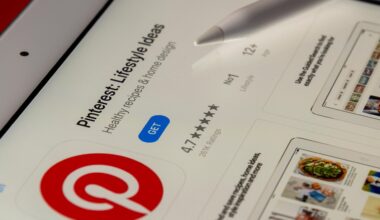Maximizing Mobile App User Acquisition: Paid or Organic Growth?
In today’s competitive marketplace, mobile app growth strategies revolve around two primary methodologies: paid and organic growth. The choice between these approaches significantly impacts user acquisition rates and long-term sustainability. Paid growth strategies typically involve the use of advertisements to attract users, which can yield rapid results and increased visibility. On the other hand, organic growth focuses on leveraging methods like app store optimization (ASO), content marketing, and user engagement to attain growth without direct financial expenditure. Both strategies have unique advantages and drawbacks, and selecting the ideal approach depends on the specific goals of the mobile app developers. Paid strategies offer immediate results, while organic methods often require more time but can lead to a loyal user base over time. The optimal strategy may involve a combination of both tactics. Understanding these distinctions is essential for developers aiming to maximize their user acquisition efforts efficiently.
The Benefits of Paid User Acquisition
Paid user acquisition strategies allow app developers to rapidly increase downloads by focusing on targeted demographics. Platforms such as Facebook, Instagram, and Google Ads empower marketers to precisely define and reach their ideal audience. This targeted approach often results in high conversion rates because advertisers can craft messages that resonate with potential users. As the user engagement rises from paid campaigns, brand awareness also improves leading to recognition in a growing market. Another advantage is the ability to scale campaigns based on performance. Developers can analyze various metrics to determine which advertisements produce the best return on investment. Furthermore, paid acquisition can work well in conjunction with organic growth strategies. For example, running paid ads while improving app store presence can complement one another effectively, fostering an increase in both visibility and credibility. Despite the costs involved, when executed properly, paid growth strategies can lead to desirable outcomes and sustainable user retention.
Organic growth strategies, however, emphasize a different approach that relies on building authentic relationships with users over time. This strategy includes techniques like optimizing for app store search terms, using relevant keywords to improve visibility, and focusing on user feedback to continuously enhance the app’s quality. Additionally, engaging users through social media, blogs, and communities can develop a sense of belonging that encourages them to share the app within their networks, further enhancing organic growth. Building a solid online presence requires commitment, but the results can be significantly rewarding. Users acquired through organic means tend to be more loyal and engaged, frequently resulting in higher retention rates. Moreover, organic growth does not require the same financial investment as paid methods, which can be advantageous for smaller developers or startups with limited budgets. By prioritizing user experience and leveraging effective content marketing strategies, businesses can significantly boost their app’s long-term potential in a cost-effective manner.
Combining Paid and Organic Strategies
The most effective approach to mobile app user acquisition often combines both paid and organic strategies. A blended method allows developers to take advantage of the immediate benefits of paid campaigns while also working on longer-term organic growth strategies. This multi-faceted approach allows for flexibility in responding to changes in market conditions. For example, if a paid campaign proves successful, developers can identify which audiences should be targeted for future ads. Simultaneously, learning from organic growth methods can enhance paid advertising efforts. Content produced for blogs or social media can feed into advertisements and boost user engagement further. Developers should analyze the data from both characteristics to optimize their ongoing strategies. Ultimately, this synergy can create a powerful marketing approach that maximizes user acquisition potential while minimizing overall costs. By continually refining these strategies, app creators can increase their effectiveness and ensure lasting growth.
The cost-per-install (CPI) model associated with paid acquisition strategies has both benefits and challenges for mobile app developers. Investors often prefer tracking cost metrics, and CPI offers tangible numbers for evaluation; understanding this metric enables developers to determine the efficacy of their paid campaigns. However, high CPI rates can drain marketing budgets quickly, particularly if the campaign fails to yield the desired results. To mitigate this risk, developers need to establish a clear budget before launching any paid campaign. Additionally, carefully targeting advertisements can help lower the CPI by ensuring that only users likely to engage with the app see the ads. Furthermore, A/B testing various ad designs and targeting strategies can refine ad efficiency, leading to reduced CPI and improved user acquisition rates. The balance between cost and quality should be at the forefront of any paid strategy. By maintaining a keen eye on these metrics, developers can better manage their paid advertisement efforts and optimize their overall marketing costs.
The Role of Analytics in Growth Strategies
Implementing robust analytics tools is crucial for tracking the performance of both paid and organic mobile app growth strategies. Comprehensive data analysis provides insights into user behavior, allowing developers to make informed decisions regarding future marketing techniques. The data generated can reveal key performance indicators (KPIs), including user acquisition costs, lifetime value, and retention rates. These insights not only help assess the effectiveness of ongoing campaigns but can also lead to the discovery of new opportunities for growth. Utilizing analytics, developers can segment users based on demographics or behavior and tailor marketing messages to each group’s preferences. Moreover, employing retention analysis can inform efforts to reduce churn rates. Continuous monitoring of these metrics empowers developers to adapt their strategies, ensuring they remain competitive and relevant in a dynamic ecosystem. Ultimately, successful mobile app growth heavily relies on data-driven strategies to maximize user acquisition and retention effectively.
In conclusion, both paid and organic growth strategies hold significant benefits and must be evaluated carefully for any mobile app endeavor. Opting for paid strategies provides quick access to a broader audience but may strain financial resources. Conversely, organic strategies foster sustainable relationships and long-term loyalty, although they require patience and consistent effort. Combining both methods allows developers to harness the strengths of each approach, leading to robust user acquisition and improving overall app performance. Data analytics plays a pivotal role in maximizing the effectiveness of these strategies, as it provides the necessary insights to improve user engagement and retention. As the mobile app landscape continues to evolve, a proactive approach incorporating both paid and organic strategies, combined with an emphasis on data analysis, will place developers in a much stronger position for success. Developers who recognize this balance and implement it adeptly will likely navigate user acquisition challenges effectively, leading to sustained growth in an increasingly competitive market.
Understanding consumer behavior and preferences is essential for creating effective mobile app growth strategies. Researching and analyzing market trends allows developers to identify potential gaps in user demands and adjust their offerings accordingly. Gathering user feedback through surveys, ratings, or in-app reviews is crucial for developing a product that aligns with user expectations. Additionally, keeping up with competitive levels of engagement can facilitate a strategy that addresses unmet needs in the marketplace. Combining market research with targeted marketing campaigns amplifies ROI potential, reaching users more likely to appreciate the app’s value. The combination of paid and organic methods often results in the best outcomes. As the landscape of mobile app development continues to evolve, strategic growth planning must account for shifting user preferences, technological advancements, and market changes. By adopting a dynamic approach that includes comprehensive research, analytics, and flexibility in execution, developers can ensure success in user acquisition efforts and ongoing loyalty to their products.


